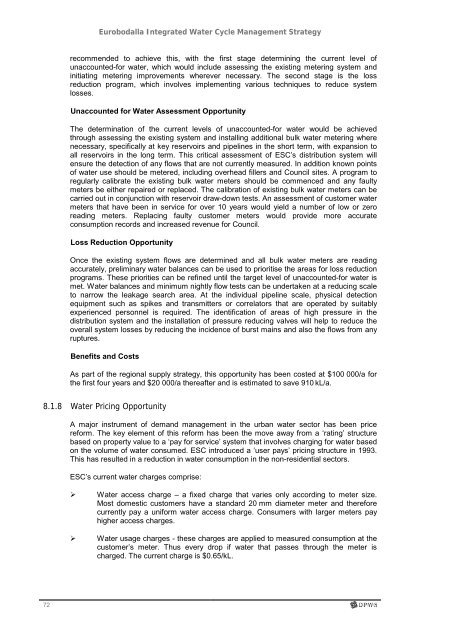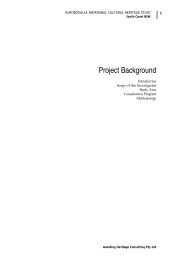Eurobodalla Integrated Water Cycle Management Strategy
Eurobodalla Integrated Water Cycle Management Strategy
Eurobodalla Integrated Water Cycle Management Strategy
Create successful ePaper yourself
Turn your PDF publications into a flip-book with our unique Google optimized e-Paper software.
72<br />
<strong>Eurobodalla</strong> <strong>Integrated</strong> <strong>Water</strong> <strong>Cycle</strong> <strong>Management</strong> <strong>Strategy</strong><br />
recommended to achieve this, with the first stage determining the current level of<br />
unaccounted-for water, which would include assessing the existing metering system and<br />
initiating metering improvements wherever necessary. The second stage is the loss<br />
reduction program, which involves implementing various techniques to reduce system<br />
losses.<br />
Unaccounted for <strong>Water</strong> Assessment Opportunity<br />
The determination of the current levels of unaccounted-for water would be achieved<br />
through assessing the existing system and installing additional bulk water metering where<br />
necessary, specifically at key reservoirs and pipelines in the short term, with expansion to<br />
all reservoirs in the long term. This critical assessment of ESC’s distribution system will<br />
ensure the detection of any flows that are not currently measured. In addition known points<br />
of water use should be metered, including overhead fillers and Council sites. A program to<br />
regularly calibrate the existing bulk water meters should be commenced and any faulty<br />
meters be either repaired or replaced. The calibration of existing bulk water meters can be<br />
carried out in conjunction with reservoir draw-down tests. An assessment of customer water<br />
meters that have been in service for over 10 years would yield a number of low or zero<br />
reading meters. Replacing faulty customer meters would provide more accurate<br />
consumption records and increased revenue for Council.<br />
Loss Reduction Opportunity<br />
Once the existing system flows are determined and all bulk water meters are reading<br />
accurately, preliminary water balances can be used to prioritise the areas for loss reduction<br />
programs. These priorities can be refined until the target level of unaccounted-for water is<br />
met. <strong>Water</strong> balances and minimum nightly flow tests can be undertaken at a reducing scale<br />
to narrow the leakage search area. At the individual pipeline scale, physical detection<br />
equipment such as spikes and transmitters or correlators that are operated by suitably<br />
experienced personnel is required. The identification of areas of high pressure in the<br />
distribution system and the installation of pressure reducing valves will help to reduce the<br />
overall system losses by reducing the incidence of burst mains and also the flows from any<br />
ruptures.<br />
Benefits and Costs<br />
As part of the regional supply strategy, this opportunity has been costed at $100 000/a for<br />
the first four years and $20 000/a thereafter and is estimated to save 910 kL/a.<br />
8.1.8 <strong>Water</strong> Pricing Opportunity<br />
A major instrument of demand management in the urban water sector has been price<br />
reform. The key element of this reform has been the move away from a ‘rating’ structure<br />
based on property value to a ‘pay for service’ system that involves charging for water based<br />
on the volume of water consumed. ESC introduced a ‘user pays’ pricing structure in 1993.<br />
This has resulted in a reduction in water consumption in the non-residential sectors.<br />
ESC’s current water charges comprise:<br />
<strong>Water</strong> access charge – a fixed charge that varies only according to meter size.<br />
Most domestic customers have a standard 20 mm diameter meter and therefore<br />
currently pay a uniform water access charge. Consumers with larger meters pay<br />
higher access charges.<br />
<strong>Water</strong> usage charges - these charges are applied to measured consumption at the<br />
customer’s meter. Thus every drop if water that passes through the meter is<br />
charged. The current charge is $0.65/kL.

















